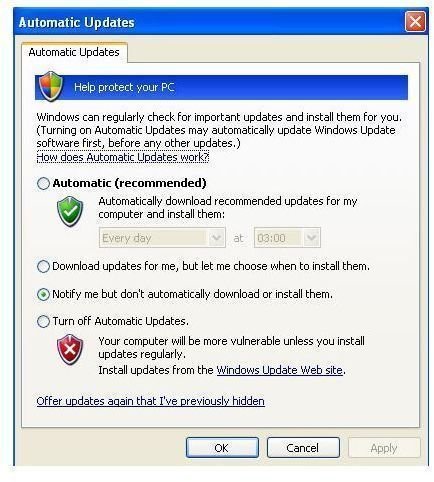Understanding The Options For Windows Automatic Updates
Changing the settings
Windows Updates include improvements to software and security ‘patches’ to fix newly-discovered flaws which hackers might try to exploit. But while Windows can automatically download and install these updates, you can control how the service works. To do this in XP, you need to open up the Control Panel then select Automatic Updates. In Vista it’s even easier: just press the Windows key, type “windows update” and press Enter. You’ll then have four options to choose from.
Automatically download recommended updates for my computer and install them
This is Microsoft’s recommended option and the one set by default. It doesn’t require any further action on your part. The downsides are that you don’t have any control of what is downloaded and installed, and you may find your PC automatically installs the updates as it’s shutting down, which means there can be quite a delay before your computer is completely closed down. You’ll have to choose a time of day for your computer to check for updates. If you leave your computer on all the time and permanently connected to the internet, the default setting of 3am should be fine. If not, it’s best to pick a time when you are usually online.
Download updates for me, but let me choose when to install them
This option means that Windows checks for updates whenever you are online and automatically downloads them to your PC. However, it then gives you the option of installing immediately (and choosing which updates to install) or waiting till later. In the latter case you simply click on the ‘Update’ icon in the bottom-right of your screen whenever you are ready. If you pick this option, but don’t install the updates before closing down your PC, you’ll find a slightly different menu when you ask your PC to shutdown. Clicking the usual ‘Shut Down’ button will make your PC install the updates before it closes. If you want to shut down without installing at that time you’ll need to click the underlined written option below the buttons.
Notify me but don’t automatically download or install them
With this option, Windows tells you whenever updates are ready to install. You then manually choose which ones to download. If you decide not to download a particular update, Windows will ask if you want to be reminded about it next time it checks. This can be quite handy if you have chosen to leave an update for a day or so, but don’t want to forget about it.
Turn off automatic updates
With this option, you won’t get any updates. This means less hassle from your computer, but could leave you prey to security problems. If you do go for this option, you should make sure to check the Windows Update website fairly frequently and download any updates which you really need – particularly those classified as ‘Critical’. Bear in mind that the updates site only works with Internet Explorer.
Which is the best option for you?
Most people either find the automatic update/install option the most convenient, or simply don’t even think about it. If you are in any doubt, this is the safest and simplest choice.
You may wish to select the middle two options if you find the automatic downloads too much of a hassle, for example if they clog up your internet connection or if they make your computer take too long to shut down (which can be a pain if you are using a machine at work and need to get out of the office quickly!)
Sometimes a particular update causes problems with third party-software. For example, an update to the Windows Media Player caused problems with an independent program used for streaming video to a TV set. In cases like this, you might want to take more control of which downloads to install and which to skip.
If you keep up to date with technology websites, you may decide it’s worth waiting a couple of days before installing new updates to find out if there are any compatibility problems. For example, a recent update to Windows caused users of the popular ZoneAlarm firewall to lose internet access. The big drawback to this is that the first couple of days after a security update comes out is the time you are most vulnerable to attack. That’s because hackers can look at the technical information behind the update and figure out more about the loophole it is intended to close.
If you want complete control of your computer, turning automatic updates off completely could be the best option. But this is really only viable for people who are very confident and are prepared to keep up-to-date and check the Windows Update site regularly.
Windows Automatic Updates Screenshots

Related Reading:
>» AutoPatcher: Automate Windows Updates and Patches
>» Explaining the June 2008 Microsoft Security Update
>» How To Get XP On Your New Computer
>» Windows Updates Downloader (WUD): Making sure you have the latest Windows Updates and Patches
